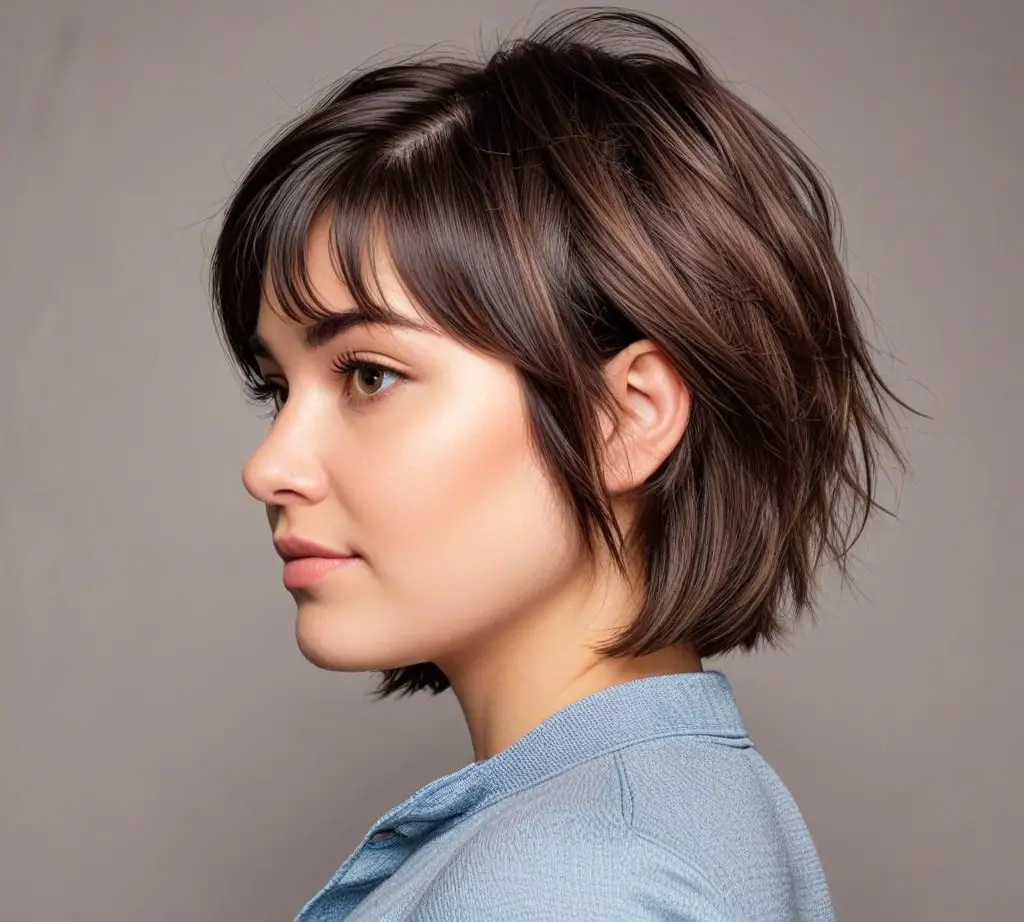Finding the perfect hairstyle for a round face shape can feel like searching for a hidden treasure. The right cut has the power to create angles, add dimension, and bring out your best features in ways that feel both natural and striking. Among all the options available today, shag haircuts have emerged as a game-changing choice for women with round faces, offering versatility and style that works with your natural bone structure rather than against it.
Shag haircuts bring something special to the table through their signature layers and textured finish. The beauty of this style lies in its ability to create vertical lines and movement that naturally elongate the face while adding personality to your overall look. Unlike blunt cuts that can emphasize roundness, shags work their magic through strategic layering that frames your features in the most flattering way possible.
Ready to discover how this iconic haircut can transform your look? The following sections will walk you through everything from understanding why shags work so well for round faces to mastering the styling techniques that make the most of your new cut. You’ll learn about different variations, maintenance tips, and common pitfalls to avoid, giving you all the tools needed to rock your shag with confidence.
What Makes Shag Haircuts Perfect for Round Faces?
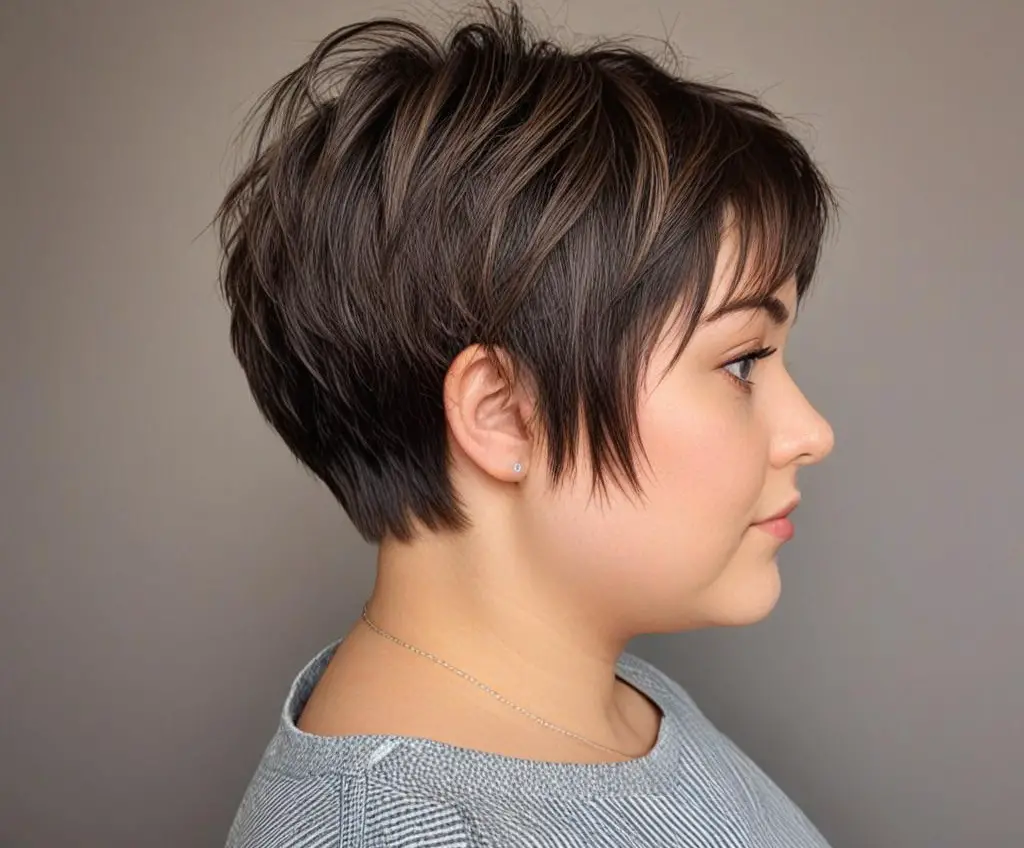
The magic of shag haircuts for round faces starts with understanding how layers interact with your facial structure. Unlike single-length cuts that can create a horizontal line across your face, shags use multiple layers to draw the eye vertically, creating an elongating effect that balances facial proportions beautifully.
The layering effect on face shape
Layers in a shag haircut work like an optical illusion for round faces. Starting shorter at the crown and gradually lengthening toward the ends, these layers create height and movement that naturally lifts the eye upward. The graduated lengths prevent hair from sitting flat against your head, which can emphasize facial roundness.
The key lies in how layers break up the circular outline of your face. Instead of following your face’s natural curve, properly cut layers create angles and lines that interrupt the roundness. This interruption is what gives your face a more oval appearance, which many consider the most balanced face shape.
How texture creates illusion of length
Texture plays a crucial role in why shags flatter round faces so effectively. The choppy, piece-y finish characteristic of shag cuts adds visual interest that distracts from facial width while creating vertical movement. This textured approach differs significantly from smooth, sleek styles that can make round faces appear wider.
When hair has varied lengths and textures throughout, it creates shadows and highlights that add dimension to your overall look. These variations in light and shadow help create the illusion of a longer, more angular face shape. The rougher texture also prevents hair from clinging to the sides of your face, which would emphasize roundness.
Professional stylists often use razoring or point-cutting techniques to achieve the perfect texture for round faces. These methods create feathery ends that move independently, adding to the vertical lines that flatter your face shape. The result is hair that looks effortlessly tousled while strategically enhancing your features.
Strategic volume placement
Volume placement in a shag haircut can make or break the look for someone with a round face. The goal is to add height at the crown while keeping the sides relatively close to the head. This strategic approach creates an elongating effect that counteracts the width of a round face.
Top layers should be cut shorter to encourage natural lift at the roots. This crown volume draws the eye upward and creates the illusion of a longer face. Meanwhile, longer layers around the face help to slim the appearance of your cheeks and jawline. The combination creates a balanced silhouette that’s both flattering and modern.
Many stylists recommend avoiding excessive volume at ear level for round faces. Too much width at this point can make your face appear even rounder. Instead, the focus should be on creating volume where it counts – at the top and in the lengths below your jawline.
Movement and dimension benefits
The inherent movement in shag haircuts offers unique advantages for round faces. Unlike static, one-length cuts, shags have built-in motion that constantly changes how your hair frames your face. This dynamic quality means your haircut works for you throughout the day, creating different flattering angles as you move.
Movement also helps to:
- Break up symmetry: The asymmetrical nature of shag layers creates visual interest that detracts from facial roundness
- Add sophistication: Moving hair appears more styled and intentional than flat, lifeless locks
- Enhance natural texture: Whether your hair is straight, wavy, or curly, shag cuts work with your natural pattern
- Create versatility: The same cut can look different depending on how you style it each day
This constant motion means you’re never stuck with one look. Your hair naturally falls into flattering positions, creating new angles and dimensions that keep your style fresh and interesting. The movement inherent in shag cuts ensures that your hairstyle actively works to flatter your face shape rather than simply sitting there.
The dimensional quality of shags also helps create depth around your face. Multiple layers at different lengths cast shadows and catch light in ways that add complexity to your overall appearance. This three-dimensional effect is particularly beneficial for round faces, as it creates the visual interest needed to balance facial proportions effectively.
The Best Shag Variations for Your Face Shape

Not all shag haircuts are created equal, especially when you’re working with a round face shape. The beauty of this versatile cut lies in its adaptability – with the right variation, you can achieve dramatically different looks while maintaining the flattering elements that make shags perfect for your face shape. Understanding which variation works best for your lifestyle, hair type, and personal style preferences will help you make the most informed decision at your next salon appointment.
Classic mid-length shag
The classic mid-length shag hits right around the shoulders and remains one of the most universally flattering options for round faces. This length provides enough weight to create beautiful movement while avoiding the width-adding effect of shorter cuts. The layers typically start around the cheekbones and cascade downward, creating that signature shaggy silhouette.
What makes this variation particularly effective is its versatility in styling. You can wear it sleek and straight for a more polished look or enhance its natural texture for that effortlessly cool vibe. The mid-length also allows for plenty of layering options without sacrificing too much length, giving you room to play with different textures and finishes.
For round faces specifically, this length works wonders because it extends past the widest part of your face. The layers that begin around your cheekbones help to create angles where your face is naturally curved, while the length below your chin draws the eye downward, creating that desired elongating effect.
Long shag with face-framing layers
If you prefer to keep your length while still enjoying the benefits of a shag cut, the long variation with strategic face-framing layers might be your perfect match. This style maintains length through the back while incorporating shorter pieces around your face that create movement and definition where you need it most.
The face-framing layers in a long shag should start no higher than your cheekbones to avoid adding width to your face. These shorter pieces work to create shadows and angles that slim your face while the longer layers maintain a feminine, flowing appearance. The contrast between the shorter front layers and longer back creates beautiful dimension that photographs wonderfully from every angle.
Long shags also offer incredible styling flexibility. You can create beachy waves, sleek straight looks, or enhance natural curls while maintaining the face-flattering benefits of the cut. The length provides weight that helps control volume at the sides of your head – a crucial consideration for round faces.
Shorter textured shag options
Contrary to popular belief, shorter shag cuts can work beautifully on round faces when executed correctly. The key lies in maintaining height at the crown while keeping the sides relatively close to the head. A shorter textured shag that hits around the jawline can actually create a very sophisticated, face-slimming effect.
These shorter variations often incorporate more dramatic layering and texturizing to create maximum movement and dimension. The pieces should be cut to flip outward slightly, creating width below the jawline rather than at the cheeks. This placement helps to balance facial proportions while maintaining a fresh, modern aesthetic.
Working with an experienced stylist is crucial for shorter shag variations on round faces. The margin for error is smaller with less length to work with, so precise cutting and strategic layer placement become even more important. When done right, a short shag can be incredibly empowering and easy to maintain.
Modern shag interpretations
Today’s shag cuts have evolved far beyond their 1970s origins, incorporating contemporary techniques and styling methods that make them more wearable and customizable than ever. Modern interpretations often feature:
- Subtle layering: Less dramatic than classic shags but still effective for face shaping
- Blended techniques: Combining traditional layering with modern texturizing methods
- Customized texture: Tailored to work with your natural hair texture rather than against it
- Versatile styling options: Cuts that look equally good air-dried or heat-styled
Modern shags for round faces often incorporate elements from other flattering cuts, such as long bobs or layered lobs. These hybrid styles give you the movement and texture of a shag with the polish and sophistication of more contemporary cuts. The result is a style that feels current while still providing all the face-flattering benefits you’re looking for.
Curtain bangs vs side-swept fringe
The fringe element of your shag can make a significant impact on how the overall cut flatters your round face. Curtain bangs have become increasingly popular for good reason – they create a natural face-framing effect that adds vertical lines while softening facial features. These bangs part naturally in the center and sweep to either side, creating an opening that elongates your face.
Side-swept fringe offers a different but equally flattering option for round faces. By creating an asymmetrical line across your forehead, side-swept bangs add angles to your face while maintaining movement and softness. The key is ensuring the fringe isn’t too heavy or blunt, which could create a horizontal line that emphasizes facial width.
Some women with round faces find that a wispy, textured fringe works better than either curtain or side-swept options. These lighter bangs add interest without overwhelming your features or creating harsh lines. The choice ultimately depends on your personal style, maintenance preferences, and how much forehead coverage you desire. Your stylist can help determine which fringe style will best complement your specific features and lifestyle.
Styling Your Shag for Maximum Flattery
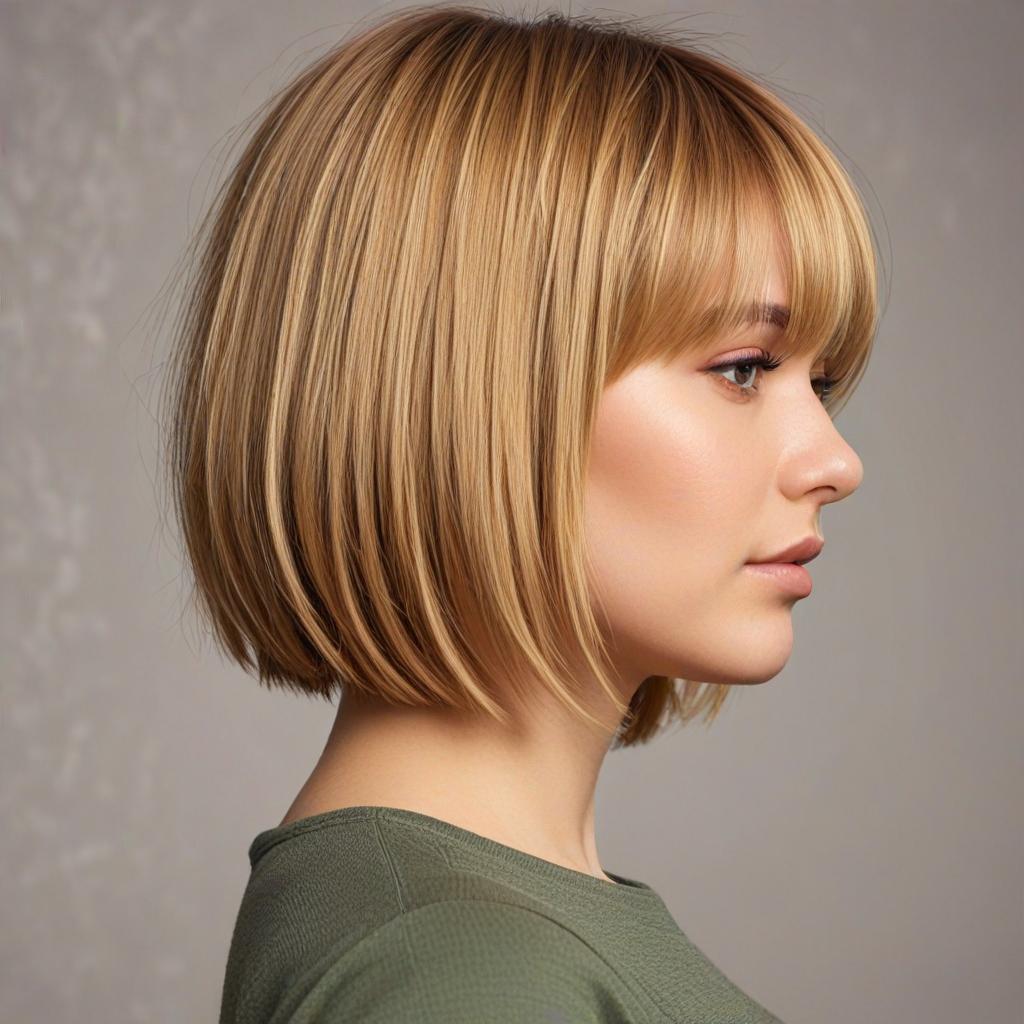
The right styling techniques can transform your shag haircut from good to absolutely stunning. While the cut itself does much of the work in flattering your round face, how you style it daily makes a significant difference in achieving that perfect balance of texture, movement, and face-framing magic. Understanding these techniques will help you recreate salon-worthy results at home.
Morning routine essentials
Your morning styling routine sets the tone for how your shag will look throughout the day. Starting with damp (not soaking) hair gives you the most control over the final result. Apply a lightweight volumizing mousse or root lift spray to the crown area, focusing on the shorter layers that need encouragement to stand up and create height.
The order of product application matters more than you might think. After your volumizing product at the roots, work a small amount of texturizing cream through the mid-lengths and ends. This product layering ensures each section of your hair gets what it needs – lift where you want height and definition where you want movement.
For round faces, the way you dry your hair can enhance or diminish the cut’s flattering effects. Use a round brush to lift the roots while directing the airflow upward at the crown. Keep the sides relatively smooth by brushing them down and slightly back, which prevents added width at the widest part of your face.
Heat styling techniques
When using hot tools on your shag, technique matters as much as temperature. Set your tools to medium heat to prevent damage while still achieving lasting results. For round faces, focus on creating vertical movement rather than horizontal volume.
A large barrel curling iron or wand works wonders for creating the perfect shag texture. Instead of uniform curls, alternate the direction of each section and leave the ends straight. This creates that signature piece-y, lived-in texture that makes shags so appealing. Wrap sections loosely around the barrel and hold for just a few seconds to avoid over-defined curls.
For those who prefer using a flat iron, try the “twist and pull” method. Take small sections, twist them, and run the flat iron down the twisted hair. This creates irregular bends and waves that look natural and effortless. Focus on creating movement that flows away from your face to maintain those face-slimming angles.
Don’t forget to use a heat protectant spray before any hot tool usage. The layered nature of shag cuts means you have varying hair lengths that may require different levels of protection. Pay special attention to the shorter layers around your face, as these tend to be more fragile and prone to heat damage.
Air-dry methods for natural texture
Many women discover their shag looks best when air-dried, especially if you have natural waves or curls. The key to successful air-drying lies in the prep work and technique you use while your hair is still damp.
Start by scrunching out excess water with a microfiber towel, which reduces frizz compared to traditional terry cloth. Apply a curl-enhancing cream or sea salt spray, distributing it evenly through your layers. The product you choose should enhance your natural texture without weighing down the carefully crafted layers.
For optimal results while air-drying:
- Scrunch upward: Encourage your natural texture by scrunching sections upward toward your scalp
- Twist pieces: Create definition by twisting small sections around your finger while damp
- Clip strategically: Use small clips at the roots to create lift while drying
- Avoid touching: Once you’ve set your hair, resist the urge to touch it while it dries
The placement of your part during air-drying also affects the final look. A slightly off-center part often works best for round faces, as it creates asymmetry that helps elongate your face. Experiment with different partings while your hair is damp to find your most flattering option.
Product recommendations by hair type
Choosing the right products for your specific hair type ensures your shag maintains its shape and movement throughout the day. Fine hair requires different products than thick, coarse hair, and using the wrong ones can sabotage even the best haircut.
For fine hair, lightweight products are essential. A volumizing foam applied to damp roots provides lift without heaviness. Follow with a texture spray on the mid-lengths and ends. Avoid heavy creams or oils that will weigh down your layers and eliminate the movement that makes your shag so flattering.
Thick hair benefits from products that control volume while enhancing texture. A smoothing cream applied to damp hair helps manage bulk, while a texturizing paste worked through dry hair creates definition and separation. Focus smoothing products on the sides to prevent unwanted width, while using texturizing products on the ends for movement.
Curly and wavy hair types need moisture without weight. A leave-in conditioner keeps layers defined and frizz-free, while a curl cream enhances natural texture. Apply products using the “praying hands” method – smoothing them over sections of hair with flat palms – to maintain the integrity of your layers while defining your natural pattern.
Remember that less is often more when it comes to product application in shag haircuts. The layered nature means products distribute differently than in one-length cuts. Start with small amounts and add more only where needed, particularly in the shorter layers that can become weighed down easily.
Maintaining Your Shag Between Salon Visits
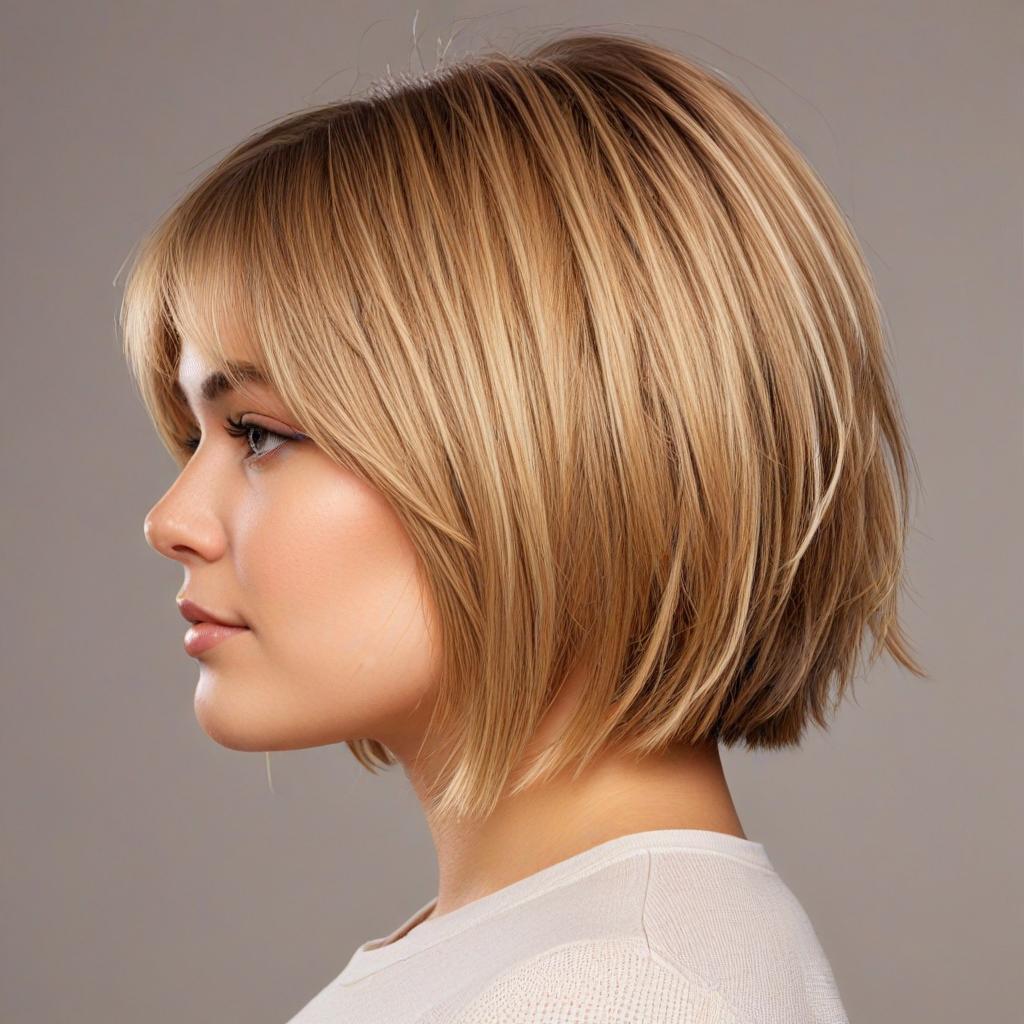
A well-maintained shag haircut continues to flatter your round face weeks after leaving the salon. The difference between a fresh-looking shag and one that’s lost its shape often comes down to simple maintenance habits you can easily incorporate into your routine. Understanding how to preserve your cut’s integrity ensures you always look your best, even as your hair grows.
The unique structure of shag haircuts means they actually improve with a bit of growth, unlike precision cuts that lose their shape quickly. However, this doesn’t mean you can neglect maintenance entirely. Strategic upkeep keeps those face-flattering layers working in your favor while preventing the shapeless, overgrown look that can emphasize facial roundness.
Trimming schedule importance
Regular trims are the foundation of shag maintenance, but the timeline differs from traditional haircuts. Most shags benefit from professional shaping every 8-10 weeks, though this varies based on your hair’s growth rate and the specific variation you’ve chosen. Shorter shags may need attention every 6-8 weeks to maintain their face-framing properties.
Between professional appointments, you might notice certain pieces growing faster than others, particularly those shorter layers around your face. While it’s tempting to trim these yourself, resist the urge unless you’re confident in your skills. Uneven trimming can throw off the entire balance of your cut, potentially creating unflattering lines that emphasize facial width.
Pay attention to how your shag grows out. Some lucky individuals find their cut improves with a few weeks of growth, as the layers settle into natural patterns. Others may notice the style losing its shape more quickly. Keep notes about how your hair behaves between appointments to help your stylist adjust the cut for optimal grow-out.
At-home texture enhancement
Maintaining the textured finish that makes shags so flattering doesn’t require daily salon styling. Simple techniques can refresh your cut’s piece-y quality between washes. Dry texture spray applied to day-old hair and scrunched through creates instant revival of your style’s movement and definition.
On non-wash days, try the “twist and shake” method. Take small sections of hair, twist them tightly, then shake them out. This technique separates the layers and creates natural-looking texture without adding products. Focus on the pieces around your face first, as these frame your features and have the most impact on the overall look.
For a quick morning refresh:
- Dampen problem areas: Use a spray bottle to lightly mist sections that have lost their shape
- Scrunch and diffuse: Reactivate natural texture with gentle scrunching and minimal heat
- Finger-comb only: Preserve texture by avoiding brushes on dry hair
- Refresh with dry shampoo: Add volume at roots while absorbing oil
Creating texture isn’t just about products – it’s also about technique. The way you handle your hair throughout the day affects how well your shag maintains its shape. Avoid constantly running your fingers through your hair, which can separate the carefully crafted layers and create frizz.
Preventing layer separation
Layer separation occurs when different lengths of your shag begin to form distinct, disconnected sections rather than blending seamlessly. This issue can make your haircut look choppy in an unflattering way and may emphasize facial roundness by creating horizontal lines.
Proper conditioning plays a crucial role in preventing separation. Use a lightweight conditioner that won’t weigh down your layers, focusing application on the mid-lengths and ends rather than roots. Once weekly, apply a hair mask to maintain moisture balance throughout all your layers, ensuring they move together cohesively.
Sleeping habits significantly impact layer separation. Switching to a silk or satin pillowcase reduces friction that can cause layers to tangle and separate overnight. If you’re prone to bedhead, try loosely securing your hair in a high, loose bun or pineapple style before bed. This preserves your layers’ formation without creating creases or flat spots.
The way you brush or comb your shag also affects layer cohesion. Always start from the ends and work upward, using a wide-tooth comb on wet hair and fingers or a specialized texturizing brush on dry hair. Aggressive brushing can destroy the careful graduation of your layers and create an unflattering puffball effect.
Refreshing your style
Sometimes your shag needs more than basic maintenance – it needs a complete refresh. This might happen after a particularly humid day, an intense workout, or simply when your style has fallen flat. Learning to revive your cut quickly saves time and frustration.
Start with strategic re-wetting. Instead of soaking your entire head, target specific areas that need attention. The crown typically benefits from a light misting and re-styling to restore height, while face-framing pieces might need more thorough dampening to regain their shape. Use your fingers to encourage the hair back into its intended formation.
Heat-free refreshing methods work wonders for maintaining your shag’s health while restoring style. Try pin curls on problem sections – wrap damp pieces around your finger, secure with a bobby pin, and let them set while you finish getting ready. Remove the pins and gently separate the curls for instant texture and movement.
A texturizing powder can be your secret weapon for quick refreshes. Unlike dry shampoo, texturizing powder adds grit and grip to hair, making it easier to recreate that piece-y shag texture. Sprinkle a small amount at your roots and through your layers, then scrunch and style with your fingers. This method works particularly well for fine hair that tends to fall flat between washes.
Common Mistakes to Avoid with Round Face Shags
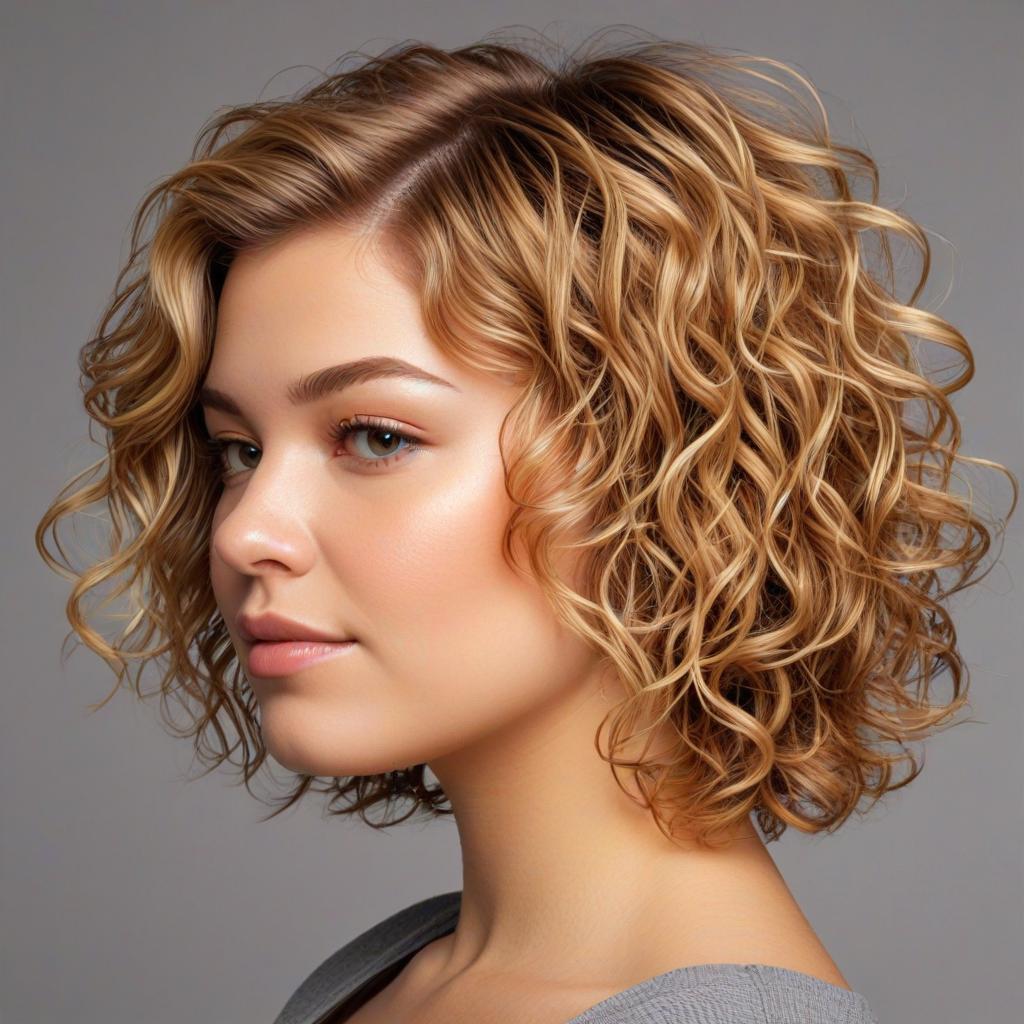
Even the most perfectly cut shag can fail to flatter if you fall into certain styling traps. Understanding these common mistakes helps you sidestep issues that could undermine your cut’s face-slimming potential. Whether you’re new to shag haircuts or looking to improve your current styling routine, awareness of these pitfalls ensures you get the most flattering results possible.
Wrong layer placement
Layer placement can make or break a shag haircut for round faces. The most common mistake occurs when layers begin too high on the head, creating volume exactly where round faces need it least – at the widest point. This horizontal volume emphasizes facial width rather than creating the desired lengthening effect.
Layers that are cut too uniformly present another issue. When every section is the same length or follows too predictable a pattern, the cut loses its ability to create flattering angles around your face. The beauty of a well-executed shag lies in its strategic irregularity, with layers that work together to create movement without adding bulk where you don’t want it.
Communication with your stylist about layer placement is crucial. Many well-meaning stylists default to standard layer patterns without considering individual face shapes. Speak up if you notice them starting layers at ear level or creating too much volume at the sides. Your input can mean the difference between a flattering cut and one that emphasizes the features you’d rather minimize.
Over-texturizing issues
While texture is essential to a good shag, too much of a good thing can backfire on round faces. Over-texturizing creates excessive volume and frizz that expands outward rather than flowing downward. This horizontal expansion is exactly what you want to avoid when trying to create a lengthening effect.
Signs of over-texturizing include hair that feels thin at the ends, excessive flyaways, and difficulty creating smooth styles when desired. The cut might look great on day one but quickly becomes unmanageable as natural oils and styling products struggle to control the excessive texture.
The solution requires finding the right balance. Your hair should have enough texture to create movement and prevent the helmet-like effect of one-length cuts, but not so much that it becomes an unruly mass. If you suspect your shag has been over-texturized, speak with your stylist about adding weight back through strategic trimming or adjusting their cutting technique for future appointments.
Incorrect bang choices
Bangs can enhance or destroy the flattering effect of your shag on a round face. Heavy, straight-across bangs create a horizontal line that emphasizes facial width – the exact opposite of what you want to achieve. Similarly, too-short bangs can make your face appear wider by cutting it in half visually.
Many women with round faces make the mistake of avoiding bangs altogether, missing out on their face-framing potential. The right bang style – whether curtain bangs, side-swept, or wispy – can actually help create more flattering proportions by adding vertical lines and asymmetry to your overall look.
Maintenance matters as much as the initial cut when it comes to bangs. Allowing them to grow too long or failing to style them properly can drag down your entire look. Regular bang trims between full haircuts keep this crucial element working in your favor. Learn to trim them yourself if needed, but start conservatively – you can always cut more, but you can’t add length back.
Styling errors that add width
Daily styling habits can inadvertently add width to your face, counteracting your shag’s slimming effects. Over-brushing is a primary culprit, as it can destroy carefully crafted texture and create a triangular silhouette that emphasizes the widest part of your face.
Using too much product, particularly at the sides of your head, creates another width-adding issue. Heavy products cause hair to stick to the sides of your face, eliminating the movement that helps create flattering shadows and angles. This mistake is especially common with those transitioning from longer, one-length styles who aren’t used to the lighter touch shags require.
The direction you style your hair matters enormously. Flipping all your hair outward creates a horizontal line that makes faces appear wider. Instead, focus on creating movement that flows down and slightly away from your face. This might mean alternating the direction of your waves or curls, ensuring some pieces move forward while others go back.
Round brushing techniques need particular attention. While lift at the crown is desirable, creating too much volume all around your head produces an unflattering globe effect. Focus your round brushing efforts on the top sections while keeping the sides relatively sleek. This targeted approach maximizes the face-slimming potential of your cut.
Heat tool positioning also impacts your final look. Holding curling irons or wands horizontally while styling creates horizontal curls that add width. Instead, hold tools vertically or at an angle to encourage downward movement. This simple adjustment can dramatically change how your styled shag frames your face.
Your Shag Journey Starts Now
Stepping into the world of shag haircuts opens up exciting possibilities for transforming how you feel about your round face shape. The versatility, movement, and strategic layering of a well-executed shag can become your secret weapon for creating the balanced, flattering look you’ve always wanted. Armed with knowledge about variations, styling techniques, and maintenance tips, you’re ready to work with your stylist to create a personalized shag that highlights your best features.
The journey doesn’t end when you leave the salon chair. Your daily choices in styling, maintenance, and product selection continue to shape how your shag flatters your face. Small adjustments in technique can yield dramatic improvements in how your haircut performs day after day. Whether you’re air-drying for effortless texture or creating polished waves for a special occasion, your shag adapts to your lifestyle while consistently delivering face-flattering results. Trust the process, experiment with different styling methods, and enjoy discovering all the ways your new shag can make you feel confident and beautiful.
Frequently Asked Questions
Q: Will a shag haircut make my round face look even rounder?
A: Not when cut correctly. A properly executed shag actually creates vertical lines and movement that elongate your face. The key lies in strategic layer placement and maintaining height at the crown while keeping sides relatively close to the head.
Q: How often should I wash my shag haircut?
A: Most shag haircuts look best when washed every 2-3 days. This schedule allows natural oils to enhance texture while preventing the flat, greasy look that can emphasize facial roundness. Dry shampoo helps extend time between washes.
Q: Can I have a shag haircut if I have very thick hair?
A: Absolutely! Thick hair actually works wonderfully with shag cuts. Your stylist will use thinning techniques and strategic layering to remove bulk while maintaining movement. The key is finding a stylist experienced with texturizing thick hair.
Q: What’s the difference between a shag and regular layers?
A: Shag haircuts feature more dramatic, choppy layers with lots of texture throughout, while regular layers typically blend more smoothly. Shags also incorporate shorter layers at the crown for volume and longer, piece-y ends for movement.
Q: Do shag haircuts work with naturally curly hair?
A: Curly shags can look absolutely stunning on round faces. The natural texture enhances the movement inherent in shag cuts. Your stylist should cut your hair dry to see how each curl falls and ensure proper layer placement for your curl pattern.
Q: How do I know if my stylist understands how to cut a shag for round faces?
A: A knowledgeable stylist will discuss layer placement, where to add volume, and how to avoid width at your face’s widest point. They should ask about your styling routine and show you how the layers will move before cutting.
Q: Can I straighten my shag haircut occasionally?
A: Yes, you can straighten your shag for variety. Use a heat protectant and focus on keeping volume at the crown while smoothing the sides. Add slight bends at the ends to maintain some movement and avoid a flat appearance.
Q: What face-framing length works best for round faces with shags?
A: Face-framing layers should typically start no higher than your cheekbones and extend past your jawline. This placement creates angles without adding width at the widest part of your face.

